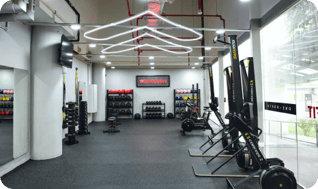Whether it’s a 10 km race or your latest marathon PB (personal best) attempt, crossing the finish line is a moment to be proud of—but the journey doesn’t end there.
Each race you take part in is an opportunity for you to pause and reflect on your performance, celebrate what you’ve done, and set new goals to keep improving as a runner. But what should you evaluate and what benchmarks should you use? And once you’ve accomplished a big goal, where do you go from there?
Don’t sweat it. We’re here to help you understand where you stand and plan for your future successes!
Why you should evaluate your performance
Evaluating your performance isn’t just about analysing your weaknesses. It’s about identifying your strengths, learning from the experience you just went through, and using that knowledge to evolve yourself.
Let’s make one thing clear: every time you complete a race, it’s an achievement, regardless of the time or distance. Taking time to reflect lets you acknowledge your progress and hard work, which will help keep your motivation high.
It’s then that you can get into the nitty-gritty of understanding what did and didn’t work—pacing, hydration, and training—that helps you refine how you approach future races.
Once you know where you stand, you can begin to create realistic and measurable goals that align with your fitness aspirations.
How to evaluate performance
It’s easy to get caught up in your feelings and assess how you performed subjectively. Luckily, there are simple and easily accessible ways to objectively analyse how you performed and gain insight to fuel your next steps.
Compare your time to averages
Benchmarking your finish time against averages for your race distance is a great way to see where you stand among other runners of a similar age and ability level. Here are some averages for typical races:
10-km average run times
|
Age groups |
Beginner (male) |
Beginner (female) |
Intermediate (male) |
Intermediate (female) |
Advanced (male) |
Advanced (female) |
|
21–30 |
01:05:30 |
01:13:55 |
00:46:43 |
00:54:17 |
00:40:54 |
00:47:55 |
|
31–40 |
01:07:02 |
01:15:48 |
00:47:49 |
00:55:40 |
00:41:51 |
00:49:08 |
|
41–50 |
01:12:12 |
01:21:37 |
00:51:30 |
00:59:56 |
00:45:05 |
00:52:55 |
|
51–60 |
01:18:43 |
01:31:29 |
00:56:09 |
01:07:11 |
00:49:09 |
00:59:18 |
Half-marathon average run times
|
Age groups |
Beginner (male) |
Beginner (female) |
Intermediate (male) |
Intermediate (female) |
Advanced (male) |
Advanced (female) |
|
21–30 |
02:24:57 |
02:43:25 |
01:43:33 |
02:00:31 |
01:30:33 |
01:46:22 |
|
31–40 |
02:27:37 |
02:46:28 |
01:45:28 |
02:02:46 |
01:32:13 |
01:48:22 |
|
41–50 |
02:39:04 |
02:59:39 |
01:53:38 |
02:12:30 |
01:39:22 |
01:56:57 |
|
51–60 |
02:53:55 |
03:22:32 |
02:04:15 |
02:29:23 |
01:48:39 |
02:11:51 |
Marathon average run times
|
Age groups |
Beginner (male) |
Beginner (female) |
Intermediate (male) |
Intermediate (female) |
Advanced (male) |
Advanced (female) |
|
21–30 |
04:57:01 |
05:33:08 |
03:34:56 |
04:08:40 |
03:08:42 |
03:40:29 |
|
31–40 |
05:02:30 |
05:37:08 |
03:38:53 |
04:11:39 |
03:12:11 |
03:43:08 |
|
41–50 |
05:25:57 |
06:04:15 |
03:55:52 |
04:31:54 |
03:27:05 |
04:01:05 |
|
51–60 |
05:56:23 |
06:53:49 |
04:17:54 |
05:08:54 |
03:46:26 |
04:33:54 |
Remember, these are just benchmarks that are helpful for context but should always be considered alongside your personal progress.
Compare your past performance
If you’ve participated in a similar race before, reflect on your latest result and compare it to previous performances. Look for trends such as:
- Consistency in splits (did you start too fast or maintain a steady effort?)
- Improvements in pace per kilometre.
- Faster finish times.
If you didn’t achieve a goal you set for yourself, it’s important to also consider external factors, like weather (Singapore’s climate can increase finish times by up to 10 minutes) or course difficulty (the Pikes Peak Marathon in Colorado, USA, has approximately 2,382 meters of elevation gain), or how well-rested you were before the event.
Reflect on your training

Ask yourself questions like:
- Were your runs consistent, varied, and aligned with your goal?
- Did your training prepare you adequately for the race?
- Did you programme long runs, speed work, and recovery?
Effective training will often be the deciding factor between race-day success and race-day struggle.
Consider how you felt during the race
Your finish time isn’t the only measure of success. You should also consider your experience during the event such as:
- Did you feel strong or sluggish?
- Were your energy levels consistent?
- Did you experience any discomfort or pain that may indicate an underlying issue?
What to do after evaluating
Now you’ve reflected, it’s time to decide what comes next.
Celebrate
First things first, take time to appreciate your effort. Book a lunch with friends, have an amazing meal, book a cold plunge with your besties, or treat yourself to a new pair of running shows. Enjoy the satisfaction of what you’ve accomplished!
Recover
Running races, especially longer ones, fatigues the body. Prioritise your recovery to ensure you’re prepared for your next challenge. There are many ways to get your body back in tip-top shape:
- Take a few days off running opting for lower-impact activities like cycling or swimming.
- Get plenty of sleep, properly hydrate, and nourish your body with healthier and less processed foods.
Listen to your body and don’t rush back into intense training. Remember, most “gains” occur while at rest, not at work.
Set new running goals
While you’re taking it a little easier, it’s a great time to create a new goal so you have something to aim for. Use what you learned from your evaluation to set your next goal—if running 10 km didn’t feel great, it’s probably not the best idea to sign up for an ultramarathon (50 km) just yet.
How to set your next running goal
Using the principles of SMART—Specific, Measurable, Achievable, Relevant, and Time-bound—goal-setting is a great way to ensure that your next goal is realistic. Here’s how:
Be specific
There’s no room for ambiguity in a good goal. “I want to improve my running,” won’t cut it, and could be amended to “I want to complete my next 10 km race in under 56 minutes”.
Make it measureable
Include numbers in your goal so you can track progress. For example, “I want to improve my average pace to faster than 6 minutes per kilometre”. This gives you a clear metric to work towards and plan your training around.
Ensure it’s achievable
A good goal should push you, but shouldn’t be beyond the realms of possibility. As we quipped before, don’t book an ultramarathon straight after your first 10 km race, and perhaps hold off booking flights for the Antarctic Ice Marathon (enduring temperatures as low as -20°C) if you’ve only ever run in warmer climates.
Keep it relevant
Your goal should align with your running ambitions. If you want to improve endurance, set a goal for an achievable longer-distance race next time, but if speed is your focus, consider the same race distance to work toward a personal best.
Set a time frame
Don’t lose momentum. Tie your goal to a specific event or a clear timeframe, such as “I want to run my first half-marathon before the end of 2025”.
Examples of SMART running goals
- Specific and measurable: “I want to complete my next half marathon in under 2 hours.”
- Achievable and relevant: “I want to increase my longest weekly run to 25 km within 3 months to prepare for a marathon.”
- Time-bound: “I want to participate in a major running event in Singapore by June and finish in the top 30% of my age group.”
Turning goals into reality
Now you’ve set goals, you need to begin achieving them. There are countless ways to achieve your fitness journey, but here’s how you might work towards it:
Create a training plan
Build a structured plan comprising:
- Longer runs to build endurance.
- Speed work like tempo runs and intervals to improve overall pace.
- Recovery runs to prevent burnout and injuries.
Track your progress
Use any one of the numerous running apps available for most smartphones or a simple journal or monitor your training sessions and load (how hard it was on a scale of 1–10, very light to maximum effort). Regular training will help you stay motivated, help you stay consistent, and help you dynamically adjust your sessions if needed.
Seek professional help
If you’re unsure how to progress or hit a frustrating plateau, we recommend seeking professional help from individuals who have experience helping runners achieve their goals. We have several services to help you stay on track and injury-free:
- Our trainers have a wealth of experience creating tailored programmes to improve strength, endurance, and running form, ensuring you stay on track and injury-free.
- Our Podiatry team specialise in comprehensive foot, ankle, and lower-limb care to optimise your health and performance.
- Physiotherapy is a cornerstone of treating existing pain or discomfort. Our knowledgeable physiotherapists can help you prepare for your next race or recover from the previous one.
Regardless of what goals you want to achieve, we’re here to help you turn yesterday’s finish line into tomorrow’s starting point.


.png?width=301&height=187&name=Website%20Navigation%20Images%20(3).png)

-1.jpg?width=1984&height=1196&name=UFIT%20Club%20Street%20Front%20(4)-1.jpg)






